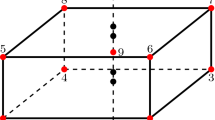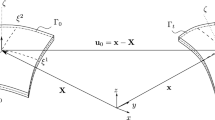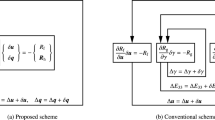Abstract
This contribution presents a refined constitutive and finite element formulation for arbitrary shell structures undergoing large elasto-plastic deformations. An elasto-plastic material model is developed by using the multiplicative decomposition of the deformation gradient and by considering isotropic as well as kinematic hardening phenomena in general form. A plastic anisotropy induced by kinematic hardening is taken into account by modifying the flow direction. The elastic part of deformations is considered by the neo-Hookean type of a material model able to deal with large strains. For an accurate prediction of complex through-thickness stress distributions a multi-layer shell kinematics is used built on the basis of a six-parametric shell theory capable to deal with large strains as well as finite rotations. To avoid membrane locking in bending dominated cases as well as volume locking caused by material incompressibility in the full plastic range the displacement based finite element formulation is improved by means of the enhanced assumed strain concept. The capability of the algorithms proposed is demonstrated by various numerical examples involving large elasto-plastic strains, finite rotations and complex through-thickness stress distributions.
Similar content being viewed by others
Author information
Authors and Affiliations
Rights and permissions
About this article
Cite this article
Başar, Y., Itskov, M. Constitutive model and finite element formulation for large strain elasto-plastic analysis of shells. Computational Mechanics 23, 466–481 (1999). https://doi.org/10.1007/s004660050426
Issue Date:
DOI: https://doi.org/10.1007/s004660050426




